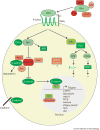Roles of Wnt proteins in neural development and maintenance
- PMID: 10851180
- PMCID: PMC4943213
- DOI: 10.1016/s0959-4388(00)00100-8
Roles of Wnt proteins in neural development and maintenance
Abstract
Many constituents of Wnt signaling pathways are expressed in the developing and mature nervous systems. Recent work has shown that Wnt signaling controls initial formation of the neural plate and many subsequent patterning decisions in the embryonic nervous system, including formation of the neural crest. Wnt signaling continues to be important at later stages of development. Wnts have been shown to regulate the anatomy of the neuronal cytoskeleton and the differentiation of synapses in the cerebellum. Wnt signaling has been demonstrated to regulate apoptosis and may participate in degenerative processes leading to cell death in the aging brain.
Figures
Similar articles
-
Reiterated Wnt signaling during zebrafish neural crest development.Development. 2004 Mar;131(6):1299-308. doi: 10.1242/dev.01007. Epub 2004 Feb 18. Development. 2004. PMID: 14973296
-
[Roles of Wnt signals secreted from the developing neural tube].Seikagaku. 1999 Oct;71(10):1243-7. Seikagaku. 1999. PMID: 10572483 Review. Japanese. No abstract available.
-
Neural patterning and CNS functions of Wnt in zebrafish.Methods Mol Biol. 2008;469:301-15. doi: 10.1007/978-1-60327-469-2_20. Methods Mol Biol. 2008. PMID: 19109717
-
Wnt signalling required for expansion of neural crest and CNS progenitors.Nature. 1997 Oct 30;389(6654):966-70. doi: 10.1038/40146. Nature. 1997. PMID: 9353119
-
Heads or tails: Wnts and anterior-posterior patterning.Curr Biol. 2001 Sep 4;11(17):R713-24. doi: 10.1016/s0960-9822(01)00417-1. Curr Biol. 2001. PMID: 11553348 Review.
Cited by
-
Arsenic inhibits stem cell differentiation by altering the interplay between the Wnt3a and Notch signaling pathways.Toxicol Rep. 2016;3:405-413. doi: 10.1016/j.toxrep.2016.03.011. Toxicol Rep. 2016. PMID: 27158593 Free PMC article.
-
The role of GSK3beta in the development of the central nervous system.Front Biol (Beijing). 2012 Jun;7(3):212-220. doi: 10.1007/s11515-012-1222-2. Front Biol (Beijing). 2012. PMID: 25688261 Free PMC article.
-
Genetic alterations of E-cadherin and beta-catenin in germinoma and teratoma: report of two central nervous system cases.Pathol Oncol Res. 2007;13(4):370-4. doi: 10.1007/BF02940319. Epub 2007 Dec 25. Pathol Oncol Res. 2007. PMID: 18158575
-
Fetal maturation revealed by amniotic fluid cell-free transcriptome in rhesus macaques.JCI Insight. 2022 Sep 22;7(18):e162101. doi: 10.1172/jci.insight.162101. JCI Insight. 2022. PMID: 35980752 Free PMC article.
-
Sonic Hedgehog Pathway Modulation Normalizes Expression of Olig2 in Rostrally Patterned NPCs With Trisomy 21.Front Cell Neurosci. 2022 Jan 4;15:794675. doi: 10.3389/fncel.2021.794675. eCollection 2021. Front Cell Neurosci. 2022. PMID: 35058753 Free PMC article.
References
-
- Brown JD, Moon RT. Wnt signaling: why is everything so negative? Curr Opin Cell Biol. 1998;10:182–187. - PubMed
-
- Wodarz A, Nusse R. Mechanisms of Wnt signaling in development. Annu Rev Cell Dev Biol. 1998;14:59–88. This paper provides an excellent review of Wnts and their functions. - PubMed
-
- Nusse laboratory. Web pages: http://www.stanford.edu/∼rnusse/wntwindow.html.
-
- Rattner A, Hsieh JC, Smallwood PM, Gilbert DJ. A family of secreted proteins contains homology to the cysteine-rich ligand-binding domain of frizzled receptors. Proc Natl Acad Sci USA. 1997;94:2859–2863. The important discovery of Wnt receptor homologues that function as competitive antagonists of frizzled receptors is presented in this paper. - PMC - PubMed
-
- Salinas PC. Wnt factors in axonal remodelling and synaptogenesis. Biochem Soc Symp. 1999;65:101–109. - PubMed
Publication types
MeSH terms
Substances
Grants and funding
LinkOut - more resources
Full Text Sources
Other Literature Sources


